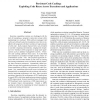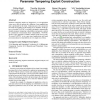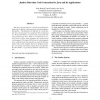96 search results - page 2 / 20 » Exploiting and Protecting Dynamic Code Generation |
CGO
2007
IEEE
13 years 11 months ago
2007
IEEE
Run-time compilation systems are challenged with the task of translating a program’s instruction stream while maintaining low overhead. While software managed code caches are ut...
CCS
2011
ACM
12 years 4 months ago
2011
ACM
Parameter tampering attacks are dangerous to a web application whose server fails to replicate the validation of user-supplied data that is performed by the client. Malicious user...
SIGSOFT
2003
ACM
14 years 5 months ago
2003
ACM
Writes via unchecked pointer dereferences rank high among vulnerabilities most often exploited by malicious code. The most common attacks use an unchecked string copy to cause a b...
ACSAC
2008
IEEE
13 years 11 months ago
2008
IEEE
In its most general form, an attack signature is a program that can correctly determine if an input network packet sequence can successfully attack a protected network application...
CGO
2003
IEEE
13 years 10 months ago
2003
IEEE
Run-time code generation is a well-known technique for improving the efficiency of programs by exploiting dynamic information. Unfortunately, the difficulty of constructing run-...



